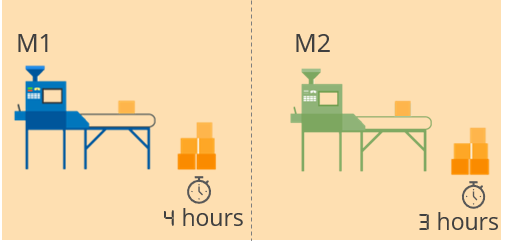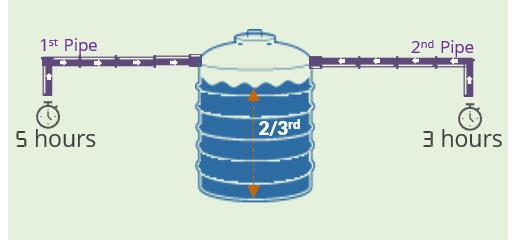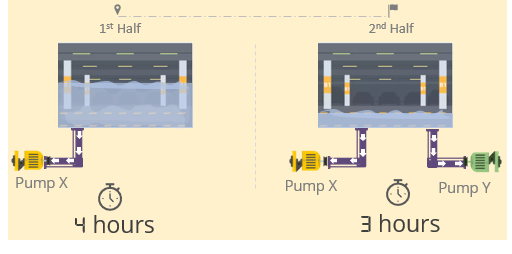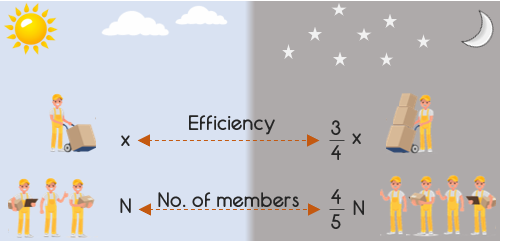Time and Work problems are the low-hanging fruit in the world of GMAT Quant Questions. You can easily learn and apply the concepts. The only question to ask is, ‘Can you solve them faster?’ The answer is Yes. In this article, we’ll compare the conventional methods of solving GMAT Quant questions on Time and work with other quick and efficient methods. The other methods being the LCM method and the efficiency (work rate) method.

In this article, we will further explain the concept of time and work with illustrative examples. Here are the key points of the article.
- Learn to solve GMAT Quant Questions on Time and Work quickly
- The conventional method of solving Time and Work Problems
- Solving Time and Work problems by LCM Method
- Efficiency (work rate) method to solve Time and Work problems
- Takeaways from the article
What will you learn from this article
In this article, you will learn:
- The application of LCM to solve Time and Work questions
- A comparative study of methods of solving Time and Work problems – by using the fraction and by using the LCM method, which one should be used and when?
- How to define efficiency and how to implement it in a problem?
In this article, we have only used official sources to help you understand the above aspects. Also, at the end of the article, we have provided some practice questions where you can apply your learning from the article.
Guillermo scored a Q50 and got an admit from the Wharton School . Read his amazing success story on how he managed his work and preparation with a rock-solid study plan.
You too can save 60+ hours of GMAT preparation with a well crafted, personlised study plan. Learn the other benefits of a well defined study plan in this article.
We can help you with a detailed study plan, customized according to your strengths and weaknesses. Create you study plan today in just 3 steps:
The conventional method of solving Time and Work Problems
In time and work problem, where people with different constant efficiencies do a certain work, we assume the total work to be constant. Mostly we solve these questions assuming the total work to be 1 unit. Let’s look at the following example:
For any strategic advice for GMAT or MBA Admissions, write to us at acethegmat@e-gmat.com. Take a free trial and get unlimited access to concept files, live sessions, and practice questions.
Example 1
It would take one machine 4 hours to complete a large production order and another machine 3 hours to complete the same order. How many hours would it take both machines, working simultaneously at their respective constant rates, to complete the order?

Solution 1A – Conventional Method
Here it is given that two machines, working independently with their different constant efficiency, complete a large production order in 4 hours and 3 hours respectively.
- As the total work done by both the machines are same, the work is constant
Let us assume the total work of the production order is 1 unit. Therefore, we can say:
- 1st machine in 4 hours can complete 1 unit of work
- Hence, 1st machine in 1 hour can complete 1/4 units of work
- Similarly, 2nd machine in 3 hours can complete 1 unit of work
- Hence, 2nd machine in 1 hour can complete 1/3 units of work
- If both the machines work together simultaneously, then in 1 hour they will complete (1/4 + 1/3) = [(3+4)/12] units of work = 7/12 units of work
- As the machines can complete 7/12 units of work in 1 hour time, to complete the whole work of 1 unit, they will take [1/(7/12)] hours = 12/7 hours
Hence, working together, both the machines will take (12/7) hours to complete the production order.
Important Observations
At the beginning of the solution, we have assumed the total constant work to be 1 unit.
- Important thing one can observe here is that assuming the total work to be 1 unit or x units can make life difficult for us – because, when we calculate the 1-day work of that person or machine, chances are very high that we will be getting fractional values
Now we all know, dealing with fractional calculations can be difficult and it increases the chances of making an error to a great extent. But the question is how we can avoid it?
Again, if you look carefully, the 1-day work of a person or a machine is calculated as the ratio of total work and the time taken.
- Therefore, if the assumed value of the total work is a multiple of the time taken, then the 1- day work will certainly be an integer value
- So, when we are assuming a value for the total work, we need to consider such a value which should be a multiple of the time taken by the different parties working on that job
- In other words, the assumed value of the total work can be taken as the least common multiple (LCM) of the given individual time taken by the persons or machines working on that job
Let us try to solve the same question using the method that we just mentioned.
Solution 1B – Changing the total work value
Let us assume the total work of the production order is 12 units. Therefore, we can say:
- In 4 hours 1st machine can complete 12 units of work
- Hence, in 1 hour 1st machine can complete 3 units of work
- Similarly, 2nd machine in 3 hours can complete 12 units of work
- Hence, in 1 hour 2nd machine can complete 4 units of work
- If both the machines work simultaneously together, in 1 hour they will complete (3 + 4) units of work = 7 units of work
- As the complete work is 12 units, to complete the order they need to do total 12 units of work together
- Combined together, the machines are completing 7 units of work in 1 hour
- Therefore, the machines will complete 12 units of work together in (12/7) hours
Hence, working together, both the machines will take (12/7) hours to complete the production order.
Takeaways
If we compare the methods explained above, fundamentally they are same, with some difference in value-wise derivation. But the most important thing to observe is that there are no fractional intermediate calculations involved in the second solution.
- As the total work is assumed to be the LCM of 3 and 4, we are avoiding the fractional calculation, and thus, saving the overall calculation time.
Let us take another example to validate this learning:
Example 2
One inlet pipe fills an empty tank in 5 hours. A second inlet pipe fills the same tank in 3 hours. If both pipes are used together, how long will it take to fill 2/3 rd of the tank?

Solution 2A – Conventional Method
In this question, it is given that one inlet pipe can fill an empty tank in 5 hours. A second inlet pipe fills the same tank in 3 hours.
As the capacity of the tank remains the same, let’s assume the capacity of the tank is 1 unit.
- As the 1st pipe takes 5 hours to fill 1 unit,
- In 1 hour it will fill 1/5 units
- Similarly, the 2nd pipe takes 3 hours to fill 1 unit
- Hence, in 1 hour it will fill 1/3 units
- If both pipes are used together, in 1 hour they will fill = (1/5 + 1/3) units = (3+5)/15 units = 8/15 units
Hence to fill 2/3rd of the tank, they will take = (2/3) / (8/15) = 2/3 x 15/8 = 5/4 hours
Let’s try solving this question with the LCM method
Solution 2B – LCM Method
As the capacity of the tank remains the same, let’s assume the capacity of the tank is 15 units.
[notice that 15 = LCM (3,5)]
- As the 1st pipe takes 5 hours to fill 15 units,
- In 1 hour it will fill 3 units
- Similarly, the 2nd pipe takes 3 hours to fill 15 units
- Hence, in 1 hour it will fill 5 units
- If both pipes are used together, in 1 hour they will fill = (3 + 5) units = 8 units
- The total work to be completed = (2/3 x 15) = 10 units
Hence, to fill 2/3rd of the tank, they will take = 10/8 hours = 5/4 hours
Takeaways
As you can see, both the problems can be solved using the conventional method as well as the LCM method. However, application of LCM method significantly decreases the calculation related, and therefore the time taken to solve a particular question becomes less.
Also, read our article on how to avoid the 3 most common mistakes in Probability
Solving Time and Work problems by LCM Method
In the following questions, we will solve the GMAT Quant Questions on Time and Work by applying the LCM method only.
Example 3
Machines A and B always operate independently and at their respective constant rates. When working alone, Machine A can fill a production lot in 3 hours, and Machine B can fill the same lot in x hours. If A and B worked alternatively, while each work for 1 hour at a time, the total work gets completed in 4 hours. What is the value of x?
Solution
In this question, it is given that machine A can fill a production lot in 3 hours, and machine B can fill the same production lot in x hours when they are working alone.
However, they will take 4 hours to complete the job, when they are working alternatively for 1 hour each.
Let us assume the total work to be 3x units (LCM of 3 and x)
- As machine A takes 3 hours to fill 3x units
- In 1 hour it will fill (3x/3) units = x units
- Similarly, machine B takes x hours to fill 3x units
- In 1 hour it will fill (3x/x) units = 3 units
- It is also given that; machine A and machine B, working alternatively, take 4 hours to fill 3x units
- Therefore, in 2 hours’ time they will fill = (x + 3) units
- Hence, in 1 hour the production lot they fill = 1/2 X (x+3) units
- Now we can say in 4 hours,
- Units filled by A + units filled by B = total production units
- Or, 4 x 1/2 x (x+3) = 3x
- Or, 2x + 6 = 3x
- Or, x = 6 hours
Hence, the value of x is 6.
Key Takeaways
Unlike the previous questions, in this question, we have a variable defined as x. Even in such case, we can apply the LCM method, as we did in the solved example, to get a quick and accurate answer.
Example 4
Working at a constant rate, pump X pumped out half of the water in a flooded basement in 4 hours. Then pump Y was started and the two pumps, working independently at their respective constant rates, pumped out the rest of the water in 3 hours. How many hours would it have taken pump Y, operating alone at its own constant rate, to pump out all of the water that was pumped out of the basement?

Solution
In this question, there are two pumps working separately at their own constant rate.
- Pump X cleared half of the water present in the flooded basement in 4 hours
- Therefore, to clear all the water, pump A would have taken twice the amount of time, i.e. 8 hours
- After pump X worked for 4 hours, pump Y also started working, and together they took 3 hours to clear the remaining half of the water
- As they took 3 hours to clear half the total amount of water, they would have taken double of that time, e. 6 hours, to clear the whole water
With this inference, we actually have a simple problem, which is very similar to the previous ones that we solved.
- Pump X takes 8 hours to clear the whole water
- Pump X and Y together take 6 hours to clear the whole water
Let us assume the total amount of water to be 24 units
- In 8 hours, pump X clears 24 units,
- Hence, in 1 hour, pump X clears 24/8 units = 3 units
- Similarly, in 6 hours. pump Y clears 24 units
- Hence, in 1 hour, pump X and Y together clear 24/6 units = 4 units
- Now in 1 hour, out of the 4 units of water cleared by pump X and Y together, 3 units were cleared by X only
- Therefore, the amount of water cleared by Y in 1 hour = (4 – 3) unit = 1 unit
As pump Y can clear 1 unit of water in 1 hour, it will take 24/1 hours = 24 hours to clear the whole amount of water, when working alone at its constant rate.
Important Observations
Apart from the usual application of the LCM method, another distinct observation we can do from this question, which is applicable to the previous question also. Let us see that:
- X can complete the whole work alone in 8 hours
- Y can complete the whole work alone in 24 hours
- X and Y together can complete the whole work in 6 hours
It is noticeable that the time taken by them together to complete the work is much less than their individual time. This is happening because of their difference in individual efficiencies.
Also, read our article on how to avoid the 3 most common mistakes in Geometry
Efficiency (work rate) method to solve Time and Work problems
As we know, efficiency essentially means the rate of work, i.e. the amount of work done in unit time.
- The more time one takes to complete a job, the less efficient the person is.
- Similarly, the less time one takes to complete a job, the more efficient the person is. Therefore, we can say that efficiency is inversely proportional to the time taken to complete the work.
In a given scenario, efficiency can be used to explain the work rate either of an individual or of a group consists of similar objects. For a group, it is generally assumed that everyone within that group has the same efficiency.
Let us take an example of a time and work problem, which relates to the concept of efficiency:
Example 5
At a loading dock, each worker on the night crew loaded 3/4 as many boxes as each worker on the day crew. If the night crew has 4/5 as many workers as the day crew, what fraction of all the boxes loaded by the two crews did the day crew load?
Solution
In this question, we have two separate groups of people to consider.
- Each member within the group has the same efficiency as other members
- However, group-wise the efficiencies are different from each other
- This means that everyone in the night crew has the same efficiency and everyone in the day crew has the same efficiency. However, the efficiency of the day and night crew, in this case, is different.
Let us look at the problem in detail.

It is given that there are two groups of workers – one operates at daytime and the other one operates at night time.
- Each worker on the night crew loaded 3/4 as many boxes as each worker on the day crew
- This statement defines the difference in efficiency of each worker belonging to the night crew and the day crew
- If we assume that each worker in the day crew loaded 4 boxes, then each worker in the night crew must have loaded 4x (3/4) boxes = 3 boxes
- It is also given that night crew has 4/5 as many workers as the day crew
- If we assume that there are 5 workers on the day crew, then there will be 5x 4/5 = 4 workers in the night crew
[notice that we have intentionally assumed the number of box loaded and the number of day crew workers as 4 and 5, to avoid any fractional calculation. Both the numbers could have been assumed as 1 or any other number – the end result would have been same, but may lead to fractional calculations]
We can show the whole data in the following table:
|
Day Crew |
Night Crew | |
| Number of boxed loaded per worker (X) |
4 |
3 |
| Number of workers in the crew (N) |
5 |
4 |
| Total boxes loaded (X × N) |
4 × 5 = 20 |
3 × 4 = 12 |
As we can see, total boxes loaded by day crew are 20 and by night crew is 12. Hence, the boxes loaded by day crew as the fraction of all the boxes loaded by both the crew = [20/(20+12)] = 20/32 = 5/8
Let us take one last example to demonstrate the application of efficiency:
Example 6
Machines X and Y work at their respective constant rates. How many more hours does it take machine Y, working alone, to fill a production order of a certain size than it takes machine X, working alone?
(1) Machines X and Y, working together, fill a production order of this size in two-thirds the time that machine X, working alone, does.
(2) Machine Y, working alone, fills a production order of twice the size in 6 hours.
Option choices:
A) Statement (1) ALONE is sufficient, but statement (2) alone is not sufficient
B) Statement (2) ALONE is sufficient, but statement (1) alone is not sufficient
C) BOTH statements TOGETHER are sufficient, but NEITHER statement ALONE is sufficient
D) EACH statement ALONE is sufficient
E) Statements (1) and (2) TOGETHER are NOT sufficient
Solution
In this question, two machines X and Y, with different efficiency, can work on a certain job.
- The question asks the number of extra hours that machine Y takes to complete the job when working alone, compared to the time taken by machine X to complete the same job, working alone.
As no other information was provided in the question stem, we will analyze the given statements
Analysing Statement 1:
- As per the information given in statement 1, machines X and Y, working together, fill a production order of the same size in two-thirds the time that machine X, working alone, does.
- If we assume that machine X, working alone, takes ‘t’ hours to complete the job, then from statement 1 we can say
- Machine X and Y, working together, complete the whole work in (2/3)t hours
- As both the machines work on their constant efficiencies throughout, we can say in (2/3)t hours machine X can complete 2/3 rd of the total work
- Therefore, in that (2/3)t hours, machine Y completes 1/3 rd of the total work
- Hence, machine Y can complete the total work in (2/3)t × 3 hours = 2t hours
- But we cannot deduce the exact value of t from this statement
Hence, statement 1 is not sufficient to answer the question.
Analysing Statement 2:
- As per the information given in statement 2, machine Y, working alone, fills a production order of twice the size in 6 hrs
- Hence, if we consider a production order of the original volume, machine Y will take 3 hours to complete it
- But from this statement, we cannot figure out any information regarding the work rate or time taken by X to complete the work
Hence, statement 2 is not sufficient to answer the question.
Combining Both Statements:
- If we consider both statements together, we can say machine Y takes 2t hours to complete the whole job, which is equal to 3 hours
- Hence, the value of t = 3/2 hours
- We also know that machine X takes t hours to complete the whole job working alone
- As we already know t is equal to 3/2 hours, we can say machine X takes 3/2 hours to complete the job working alone
- Therefore, machine Y takes (3 – (3/2)) hours = 3/2 hours more than what machine X takes to complete the work, working individually
As information from both the statements is required to solve the question, we can say the correct answer choice is Option C.
Also, read our article on how to avoid the 3 most common mistakes in Permutations and Combinations.
Takeaways from this article
To quickly solve GMAT Quant Questions on Time and Work, please refer to the following takeaways and keep them in mind.
- In Time and Work problems where we are supposed to assume the value of total work, it is always a good practice to assume the total work as the LCM of the given days (or any multiple of LCM), rather than assuming the total work as 1 unit – as it decreases the complex calculations involved with fractions
- LCM method can still be applied when one of the data points are given in terms of variable
- Efficiency is inversely proportional to the time taken
- When working in groups, all are considered to be equally efficient within a group, whereas people have different efficiencies across groups
Read our next article on 3 deadly mistakes you need to avoid in Time and Work Problems
Questions on time and work are very commonly asked on the GMAT. Ace GMAT Quant by signing up for our free trial and get access to 400+ questions. We are the most reviewed online GMAT Prep company with 2400+ reviews on GMATClub.













